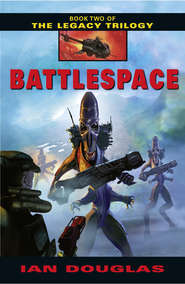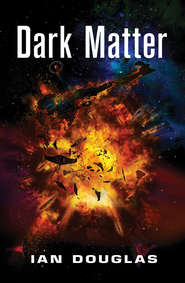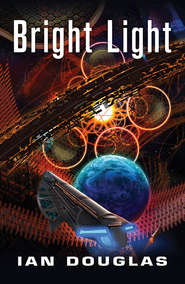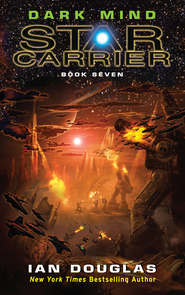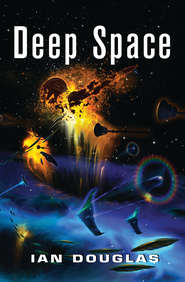По всем вопросам обращайтесь на: info@litportal.ru
(©) 2003-2024.
✖
Singularity
Настройки чтения
Размер шрифта
Высота строк
Поля
“Wait a minute,” Ryan said. “I thought stars like Sol were too small to become black holes.”
“Exactly,” Cleary said. “If a star of about three solar masses collapses, it becomes a black hole. A smaller sun becomes a neutron star … and if it’s smaller still, like our sun, it becomes a white dwarf.”
“The object we are observing,” Dra’ethde pointed out, “is clearly artificial. A natural stellar collapse would result in a sphere … or, rather, a spherical ergosphere, with the singularity within.”
“The thing,” Cleary said, “is roughly twelve kilometers long and about one wide, and it appears to be rotating around its long axis at close to the speed of light. Whoever built it can do tricks with mass and gravity that we can’t even imagine yet.”
“Okay,” Gray said. “It’s super-tech. But what does it do?”
“That’s what we’re trying to decide,” Cleary said. “Our best guess so far is that it’s a kind of Tipler machine … but we know that that is absolutely impossible.”
“Perhaps,” Gru’mulkisch said quietly, “the builders do not agree with you as to what is or is not possible.”
Gray had to access the ship’s library and download information on Tipler and the machine named after him. Frank Tipler had been a mathematical physicist and cosmologist in the twentieth century who’d written a paper based on the van Stockum-Lanczos solutions to the equations of general relativity. That paper, “Rotating cylinders and the possibility of global causality violation,” had presented the possibility of what were called closed timelike curves appearing in the vicinity of a very long, very massive, rapidly rotating cylinder. According to Tipler, if you could stretch a black hole into a rigid length of spaghetti and spin it up to something like 60 percent of the speed of light, some billions of rotations per second, the thing warped surrounding space in such a way that it would open portals not through space, but through spacetime, the two being inextricably linked within Einstein’s equations.
The Tipler machine, in other words, was a time machine.
Toward the end of the same century, however, another physicist, the legendary Stephen Hawking, had proven that it simply couldn’t be done. In order to open a doorway into the past, you would need a rotating cylinder that was infinitely long.
The Tipler time machine became a footnote in the physics textbooks, and was eventually almost forgotten.
Perhaps, as Gru’mulkisch had just suggested, the beings who’d built that thing out there hadn’t read the same textbooks.
Gray felt a rising tingle at the back of his scalp.
“Who,” he said quietly, “could possibly have built such a thing?”
“That is what we would like to know,” Cleary replied.
Shadow Probe 1, Drop Bay 1
TC/USNA CVS America
Outer System, Texaghu Resch System
1224 hours, TFT
“Shadow Probe One ready for launch,” Lieutenant Christopher Schiere reported.
“Copy that, One. You are clear for launch,” Commander Avery replied. “Good luck!”
“Let’s just hope it’s better luck than last time,” Schiere muttered.
“What was that, Probe One?”
“Nothing, Boss. Let’s get this show going.”
“And launch in three … two … one … launch!”
The CP-240 Shadowstar hurtled down the two-hundred-meter launch tube at seven gravities, emerging from the center of America’s shield cap 2.39 seconds later and traveling at 167 meters per second. The CP-240 was a near twin to the conventional SG-92 Starhawk strike fighter but was designed for just one task: reconnaissance. One of the ships assigned to America’s VQ-7 recon squadron, the Sneaky Peaks, Schiere’s craft carried no weapons other than a collection of VR-5 recon drones. Slightly more massive than a Starhawk, it possessed a Gödel 2500 artificial intelligence, a self-aware system far more powerful and flexible than the Starhawk AIs.
And it could bend light around itself in a way that gave it near invisibility.
Lieutenant Christopher Schiere was an old hand with the Sneaky Peaks—named for their CO, Commander James Peak. Sneak and peek was their squadron motto, and they were an effective means of exploring ahead of the battlegroup to see what might be lurking up ahead.
Schiere’s last mission had been a high-velocity flyby of the manufactory orbiting Alphekka, and it had nearly been his last. Attacked by dozens of Turusch fighters, all he’d been able to do was tuck himself into a tight little invisible ball and hurtle on into emptiness. A day later, he’d risked decelerating and sending out a questing signal, a rescue beacon. One of America’s SAR tugs had picked him up forty hours later.
It had been a near thing. Finding an all-but-invisible sliver of a spacecraft many AUs from the battlespace was far worse than looking for the proverbial needle in a haystack. Needles you could see. …
Despite the near miss, Schiere had put up his hand when the skipper had asked for a volunteer. “What, are you nuts, Chris?” Peak had asked him.
“It’s that damned horse, Skipper,” Schiere had replied. “I need to get back on.”
His post-mission psych check had flagged him as marginal, a downgrudge that normally would have taken him off of active flight status for at least six weeks, followed by re-evaluation. Schiere had fought the listing. Dr. Fifer and his damned psychtechs were not going to ground him.
Amazingly, the psych department had relented—no doubt, as Schiere had told his buddies in the squadron, because they knew recon flight officers were nuts. Three days locked up inside a Shadowstar cockpit had been rough, yeah, and the thought that he might drift for eternity through the emptiness had preyed on him.
But he’d made it. They’d found him. He was good to go!
And he wanted to go, to go now, before he lost his nerve.
“America CIC, this is Shadow Probe One, handing off from PriFly and ready for acceleration. Shifting to sperm mode.”
“Copy that, Shadow Probe One,” a new voice said. “You are clear to accelerate at your discretion.”
“Roger, America,” he replied. “Bye-bye!”
He accelerated at fifty thousand gravities, and America vanished astern so swiftly it might have been whisked out of the sky.
And Christopher Schiere once again was as utterly alone as it was possible for a person to be.
The objective lay some eighty light minutes from America’s emergence point. At fifty thousand gravities, Schiere’s Shadowstar was pushing 99.9 percent of c in ten minutes, and the universe around him had grown strange.
CIC
TC/USNA CVS America
Outer System, Texaghu Resch System
1225 hours, TFT
“Shadow Probe One is away, Admiral,” the tactical officer reported. “Time to objective is ninety-three minutes, our reckoning.”
“Thank you, Commander,” Koenig told him. He noted the time. An hour and a half for the probe to reach the mysterious object, plus eighty minutes for the returning comm signal to reach the America—they could expect to receive a transmission in another 173 minutes, at around 1517 hours, or so.
Assuming the pilot didn’t encounter hostiles.
He opened a channel. “Commander Peak? Koenig. Who’s the VQ-7 pilot who just launched?”







